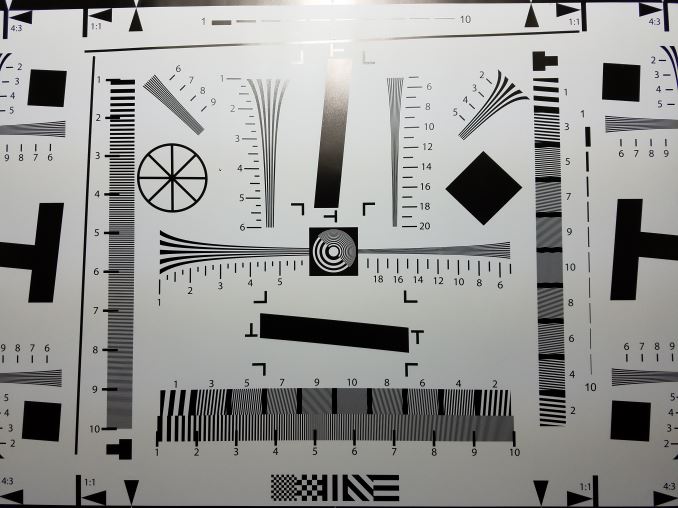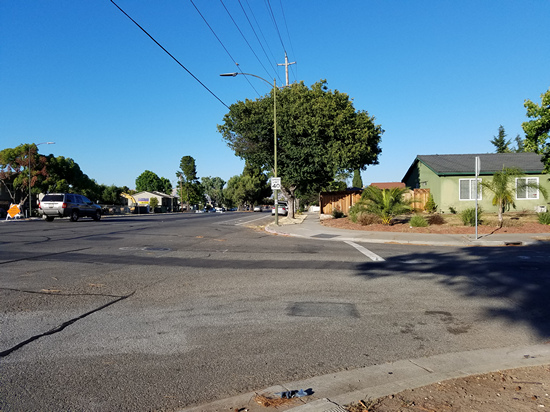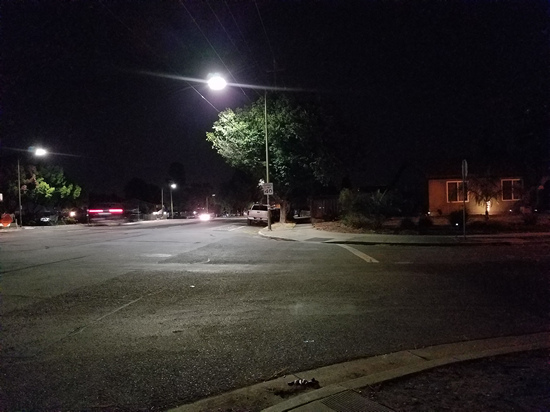The Samsung Galaxy S7 and S7 edge Review: Part 2
by Joshua Ho on July 5, 2016 8:00 AM ESTStill Image Performance
Now that we’ve covered the user experience associated with the camera, we can start to go over the output that the Galaxy S7 is capable of producing. In order to do this we continue to carry over the same sorts of benchmarks that we’ve used in 2015, which is to say that we use a combination of standardized test charts with semi-controlled lighting along with real world testing to try and see how the device actually performs outside of rather simplistic tests.
Starting with the ISO chart we can see quite clearly that the Galaxy S7 has lost noticeable ground in resolution relative to the Galaxy S6 when you look at the center of the photo, but at the edges of the photo the Galaxy S7 actually appears to have the lead against the Galaxy S6. The same sort of story plays out with the HTC 10 as it clearly has more detail than the Galaxy S7 at the center of the photo but the edges of the HTC 10’s test chart shot shows clear defocus that gets pretty terrible at the corners.
| Daytime Photography |
In our daytime landscape test we can see the sorts of effects that the smaller pixel size has had on the Galaxy S7. Relative to the Galaxy S6, there’s almost no delta in the detail resolved, but right away it’s obvious that the sharpening halos have become even more obvious than before which is concerning. These observations also apply to the Galaxy Note5, although the Note5 is a bit sharper due to some changes in image processing relative to the Galaxy S6. However I wouldn’t say that there’s an appreciable difference one way or another here.
Relative to the iPhone 6s, the Galaxy S7 is basically identical in detail as well, but the iPhone 6s tends a bit warmer and has much, much less obvious post-processing that is extremely obvious on the distant trees that contrast against the sky. This is actually kind of surprising for me given that the Galaxy S7 has a larger sensor, but I suspect the dual pixel AF, wider aperture, and slightly wider field of view are eliminating whatever advantages increased sensor size might bring.
Compared to the HTC 10, the Galaxy S7 has better edge contrast, but generally it looks like textures have better detail on the HTC 10. I haven’t been able to do extensive RAW comparisons yet but it looks like HTC is just blurring luminance noise out too aggressively here for whatever reason. I’m not sure what causes this in image processing, but given how other OEMs like LG and Apple are fully capable of mostly eliminating color noise from their photos while retaining most of the detail that their cameras are capturing HTC would do well to do the same.
The final point of comparison I want to make here is the LG G4/G5. Although the G5 seems to have started an AF run in the middle of the capture, the areas where the photo is actually focused are arguably better than what the Galaxy S7 can put out. Even next to the G4, the Galaxy S7 falls short. I’m honestly not sure why LG doesn’t get more credit here, because next to Apple they seem to have the best image processing algorithms in the industry.
| Low Light Photography |
While daytime quality is critical, I suspect most people are going to be interested in low light performance as this is usually the hardest test for any OEM to get through. It’s taken years for OEMs to start shipping acceptable image processing in low light that wasn’t just a smeary and oversharpened mess, so getting this right is pretty important to say the least.
Unfortunately, the Galaxy S7 is just a bit disappointing here. The LG G5 is just clearly better here as noise reduction is better in pretty much every way and it looks a lot more natural due to less obvious sharpening halos. I would also argue that the HTC 10 is also better here due to its better texture detail and better handling of shadow detail, even if edges are softer.
The Galaxy S7 also has this strange streaking light flare with bright sources that I just couldn’t get rid of despite wiping the lens multiple times with a clean cotton cloth, which was done for every phone in this test before taking the picture. In fairness, the Galaxy S7 is still the fastest camera out of everything in this test, but it comes at the cost of rather disappointing output for me. The Galaxy Note5 looks like it might even be slightly better than the Galaxy S7, which is a weird regression when the general idea of going to a larger pixel size is to get better low light performance. As alluded to earlier, the cost of the dual pixel AF system may be sensitivity due to the dual photodiodes and light barrier to generate a phase detection pixel. While this is just one test example I’ve spent a lot of time playing with the camera on the Galaxy S7 and in general its low light performance is fairly similar to what you see above. The only time where I really see the Galaxy S7 lead is in extreme low light conditions where everything is reaching ISO and shutter speed limits.
Overall, while the user experience of the Galaxy S7's camera is industry-leading, the Galaxy S7 represents a somewhat unfortunate sidegrade in camera quality at best. I would argue that Samsung has gone in the wrong direction with their camera processing as they seem to be relying on strong noise reduction and sharpening more than ever before. The Galaxy S7 also retains the oversaturated color rendering of the Galaxy S6. While I'm sure most people are happy with these results, Apple and LG tend to have more accurate color rendition with their cameras. While HTC doesn't quite nail color rendition, they are arguably closer to reality than Samsung is. Hopefully with their next device they manage to maintain their class-leading speed, but with better post-processing and overall image quality.



















266 Comments
View All Comments
Michael Bay - Wednesday, July 6, 2016 - link
Somebody hasn`t lived in the nexus times then.more-or-less - Wednesday, July 6, 2016 - link
What has nexus got to do with themes?? your statements make no sense at all.Impulses - Thursday, July 7, 2016 - link
I don't get it either, and I have a Nexus 5... Shouldn't a theme just be a replacement of a series of textures and color profiles that are basically static and loaded just the same regardless of how they're tweaked?I found the comment by Joshua kinda suspect too, maybe I'm missing something, BUT I don't see how themes really help with Samsung's UI foibles either.
You might get rid of their color choices, at best, but it does nothing for all the substituted apps and extra UI elements you can't alter (never mind background processes and optimizations); those are the bigger issue with TouchWiz.
JoshHo - Thursday, July 7, 2016 - link
I'm not sure what exactly was done in the Android theming system but somehow some third party themes have noticeable effects on performance.Artmi$$ - Wednesday, July 6, 2016 - link
excuse me but where is the HTC 10 complete review ???retrospooty - Friday, July 8, 2016 - link
HTC 10 review? That isnt made by Apple, it wont come until 2017, if at all.lopri - Wednesday, July 6, 2016 - link
How AT can publish this low quality review after such a long wait is beyond me. It is almost as if the author, after many (justifiable) criticism directed to him, had decided to stick it up to readers in defiance.So very disappointed. Sort of editing and quality control by a seasoned reviewer is warranted, IMO.
R. Hunt - Wednesday, July 6, 2016 - link
Anandtech is slowly fading into irrelevance, this review being perfect proof of it: too late to matter, content not really warranting the long wait.ntp - Wednesday, July 6, 2016 - link
The Gear VR received no mention even though it's the best mobile VR and games like Anshar Wars 2 are insanely fun in multiplayer.The Vulkan API deserves at least some words, since it will increase performance significantly when proper implementations will come out.
Waterproofing adds considerable value also, since it can make the difference between buying a working phone or a brick.
And regarding cameras, how can you even compare Apple's F2.2 with F1.7?! They are in completely different leagues yet I see no mention of the advantages Samsung brought by having the fastest lens of any phone: lower exposure times (less handshake) or less noise. If you'd have used a DSLR camera you'd know that the F number is basically what you pay for in a lens, all other things being the same.
This is not a biased review. It's just... unprofessional. Too bad it took AT so long for something so incomplete.
Impulses - Thursday, July 7, 2016 - link
There's a heck of a lot more to a DSLR lens than aperture, specially if you're not chasing shallow DoF (which a phone can't manage in most circumstances).f2.2 vs f1.7 is actually 3/4ths of a stop, which isn't nothing but it's not like night and day either... It means shooting at 1/40 vs 1/80 or less than one ISO stop higher.
Nevermind that very often the f stop lies and it's not a true measure of light transmission, since it's merely and literally a ratio representing a physical iris measurement.
Glass coatings and other factors can affect actual light transmission, which is why cine lenses have more accurate T stops... Then you gotta figure in sensor size and efficiency, etc etc.